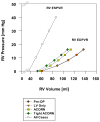Biventricular finite element modeling of the Acorn CorCap Cardiac Support Device on a failing heart
- PMID: 23643546
- PMCID: PMC3702266
- DOI: 10.1016/j.athoracsur.2013.02.032
Biventricular finite element modeling of the Acorn CorCap Cardiac Support Device on a failing heart
Abstract
Background: The Acorn CorCap Cardiac Support Device (CSD; Acorn Cardiovascular Inc, St. Paul, MN) is a woven polyester jacket that is placed around the heart and designed to reverse the progressive remodeling associated with dilated cardiomyopathy. However, the effects of the Acorn CSD on myofiber stress and ventricular function remain unknown. We tested the hypothesis that the Acorn CSD reduces end-diastolic (ED) myofiber stress.
Methods: A previously described weakly coupled biventricular finite element (FE) model and circulatory model based on magnetic resonance images of a dog with dilated cardiomyopathy was used. Virtual applications of the CSD alone (Acorn), CSD with rotated fabric fiber orientation (rotated), CSD with 5% prestretch (tight), and CSD wrapped only around the left ventricle (LV; LV-only) were performed, and the effect on myofiber stress at ED and pump function was calculated.
Results: The Acorn CSD has a large effect on ED myofiber stress in the LV free wall, with reductions of 55%, 79%, 92%, and 40% in the Acorn, rotated, tight, and LV-only cases, respectively. However, there is a tradeoff in which the Acorn CSD reduces stroke volume at LV end-diastolic pressure of 8 mm Hg by 23%, 25%, 30%, and 7%, respectively, in the Acorn, rotated, tight, and LV-only cases.
Conclusions: The Acorn CSD significantly reduces ED myofiber stress. However, CSD wrapped only around the LV was the only case with minimal negative effect on pump function. Findings suggest that LV-only CSD and Acorn fabric orientation should be optimized to allow maximal myofiber stress reduction with minimal reduction in pump function.
Copyright © 2013 The Society of Thoracic Surgeons. Published by Elsevier Inc. All rights reserved.
Figures




References
-
- Mann DL, Acker MA, Jessup M, Sabbah HN, Starling RC, Kubo SH. Clinical evaluation of the CorCap cardiac support device in patients with dilated cardiomyopathy. Ann Thorac Surg. 2007;84:1226–35. - PubMed
-
- Starling RC, Jessup M, Oh JK, et al. Sustained benefits of the CorCap cardiac support device on left ventricular remodeling: three year follow-up results from the Acorn clinical trial. Ann Thorac Surg. 2007;84:1236–42. - PubMed
-
- Wenk JF, Ge L, Zhang Z, et al. A coupled biventricular finite element and lumped-parameter circulatory system model of heart failure. Comput Methods Biomech Biomed Engin. 2012 [E-pub ahead of print] http://dx.doi.org/10.1080/10255842.2011.641121. - DOI - PMC - PubMed
Publication types
MeSH terms
Grants and funding
LinkOut - more resources
Full Text Sources
Other Literature Sources

